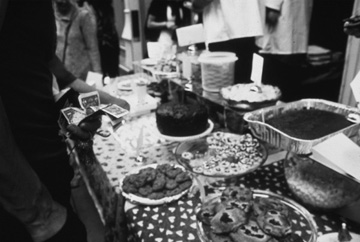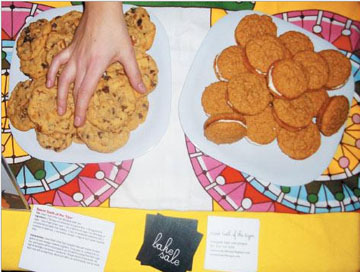
Elaine Tin Nyo, "The Bake Sale." Deitch Projects, NYC, 1997.
I am an arts administrator, which is arguably the second invisible position in line behind the artist. The administrator’s cultural discount is not only applied when independently presenting an exhibition without receiving a curatorial fee, or when asked to moderate a panel discussion without compensation; it is also applied daily in the work force, when we are paid less than what we are worth at gallery jobs, museum positions, as editors and writers (not to mention when those jobs are lost due to layoffs). While the financial downturn is a particularly difficult time for artists and arts administrators, it seems that the issue of the artist’s “cultural discount” (a principle that has been incorporated by Andrew Ross in his 2000 Social Text article “The Mental Labor Problem”), in which “artists and other arts workers [are] accept[ing] non-monetary rewards [and] the gratification of producing art as compensation for their work, thereby discounting the cash price of their labor,” has perhaps existed long before the 2008-09 recession but just now is being challenged. I am interested in discussing how existing economic models for arts funding as well as emerging models of arts fundraising may support or defy this cultural discount.
W.A.G.E., the arts activist group based in NYC, has been rallying for changes in arts infrastructure to include fees paid to artists and cultural workers as compensation for their labor. An attempt to create movement in this stagnant situation—while waiting for the government to act in support of the arts, and for museums and art institutions to adopt a “best practices” policy that includes a valid fee structure—has been initiated. Groups like InCUBATE (Institute for Community Understanding for Art and The Everyday), FEAST (Funding Emerging Art with Sustainable Tactics), and my own project, Sweet Tooth of the Tiger (a mobile bake sale table that engages ways of thinking about circulating capital in the arts), are functioning as socially collaborative practices that view a dissolved hierarchy shifting the public’s role from distant viewer to active participant as integral to preserving artist networks and communities. Much like socially collaborative artwork (such as the work of Kaprow and Fluxus), a desire for art’s sake is at the heart of these groups (for more on this subject, see RoseLee Goldberg’s text Performance Art: From Futurism to the Present or Claire Bishops’s Participation: Documents of Contemporary Art). Unfortunately, the cost of living in U.S. cities has skyrocketed while the infrastructure of the art institution hasn’t changed much. Adapting to these circumstances, these groups view arts administration as a creative practice that is adept at problem-solving in a dysfunctional system. By incorporating an economy that is facilitated by a democratic model, in which the public pays small amounts of money directly to the artist (contrarily, criticism has recently cropped up regarding “new” economic models in the arts; see Morgan von Prelle Pecelli’s Jan 29, 2009 City Council Testimony), we are able to support artists in their pursuit of sustainable practice both monetarily and culturally as a way to undermine the authority of the art institution and its infrastructure.
In his essay, “Sure, everyone might be an artist…but only one artist gets to be the guy who says that everyone else is an artist” (in What We Want Is Free: Generosity and Exhchange in Recent Art, edited by Ted Purves), Bill Arning writes about NY-based artist Elaine Tin Nyo’s bake sale at Deitch Projects several years ago. Artists baked sweets and sold them to passersby, intending to “analyze the relations between galleries, critics, curators, and artists.” Arning alludes to the art world’s confusion regarding the process of sustainable practice through self-sufficient means, perhaps further alluding to the rigid infrastructure that ignores the issue of the artist’s cultural discount. He writes,
Bake sales are, of course, a small-town American way of raising funds for modest projects of civic betterment. The art world tends to raise its funds with black tie parties, celebrities, and blockbuster auctions. The confusion between fundraising styles maligned neither, but rather reminded us that art is an activity that takes place within a network of other worthy activities, and that its systems of promotion and self-sustenance are as strange and as normal as baking and selling a pie to pay for new soccer uniforms.
Here, Arning engages in the discussion of participatory and socially collaborative practice that blurs the distinction between art and life, and in turn sustains itself by recasting a capitalist economy that is in favor of the artist rather than the institution.
While I persist in unpacking the details of these emerging artist economies that I am helping to create, it must be considered that this democratic system, which raises funds for artists, is still neglectful of the arts administrator. The administrator attempts to create access points for the public in an effort to navigate issues such as visual literacy and artistic citizenship. This desire to bring people closer to the arts undergirds the administrator as a valuable position in the art ecosystem. As an arts administrator, my consistent end goal is that of assisting artists with their projects. In my effort to formulate a sustainable model for these artists, I am curious about how to sustain my own work, pay my rent, my cell phone bill, my Internet connection, and secure all of the cash flowing into renting equipment, creating announcements, and competing with the for-profit system that has capital for these sorts of things. I feel that I must function something like a small business, where I, as the “owner,” pays myself last. This act of artists and administrators having to function like businesses is outdated and is a non-working method that naturalizes creative practice as not worthy of monetary compensation.

Sweet Tooth of the Tiger's Bake Sale
As I work to discuss new avenues of circulating capital in the arts by organizing socially collaborative fundraising sites in support of the artist, I am simultaneously working to reveal the position of the arts administrator as undeserving of cultural capital as the only reward for their work. Seemingly, this situation exists as a catch-22 cycle, by supporting the artist and neglecting oneself. This past week I had the opportunity to organize and moderate a panel discussion that addressed this cycle. The panel was called (Alternative) Arts Funding for Sustainable Creative Practice and was held last Thursday, April 30, at NYU Steinhardt’s Barney Building. Panelists included Ruby Lerner from Creative Capital, Tim Cynova from Fractured Atlas, Bryce Dwyer from InCUBATE, Jeff Hnilicka from FEAST, and A.K. Burns from W.AG.E. As we moved across the stage, each panelist spoke on behalf of his or her organization about how the light of the recession has illuminated issues of the cultural discount that artists encounter. Responses ranged from seasoned professionals like Lerner, who mentioned that ten years ago during the NEA crash, it was innovative to support artists who were challenging cultural and artistic expectations. She went on to say that as Creative Capital continues to build a solid support structure for artists, the organization persists with its ear to the ground, exploring how best to adapt to artists’ needs.
While Creative Capital was built on the answering of questions that existing funding institutions failed to acknowledge, the panel also heard from brand-new organizations like FEAST and InCUBATE, who are beginning by asking questions and experimenting with different models for creative production. Dwyer, from InCUBATE, cited that in an effort to challenge the inefficient model of the non-profit grant (the process in which an artist’s extended time and effort are spent writing grant applications that may suppress their desire to experiment, as well as the non-immediacy issue of grants often taking months or years to materialize), InCUBATE does not apply for grants (although they do have a fiscal sponsor, Fractured Atlas, for support on managing their operations). Instead, InCUBATE relies on a community of like-minded organizations to pool their resources and share the storefront space they occupy in Chicago.
I was privileged enough to see their space, called the Orientation Center, and meet these other organizations (AREA Chicago, a magazine and events series about culture and politics in Chicago and the Chicago Underground Library, an eclectic city-specific library of publications and zines made by Chicagoans) while I was in Chicago for a reciprocal panel discussion organized and moderated by Abby Satinsky and Roman Petruniak of InCUBATE. The panel was at the NEXT Art Fair in Chicago and was titled Doing it Together: Artist-Run Support Networks. Panelists included myself for Sweet Tooth of the Tiger, Randall Szott for The Department of Aesthetics in Chicago, and Robin Hewlett for Backstory Café at the Experimental Station in Chicago. We all presented the various ways our creative practice attempts to challenge existing modes of creative practice while simultaneously staying somewhat off the grid. Wonderful debates about artistic labor and gift economies ensued, while ideas of “cultural discount” and “sweat equity” were compared and contrasted.
Both audiences for the panels in New York and Chicago were attentive and interested, and while it seemed that most viewers were quietly contemplating the issues being raised and digesting the information, each panel added to the momentum and buzz of discussing art as labor, recasting ideas of capital to work for artists, and the value of the artist and arts administrator. I’m incredibly excited and anxious to continue opening up these ideas for discussion and ask interested members of the arts community—in New York, Chicago and beyond—to persist in working hard to establish various platforms for dialectic practice in an effort to recognize action as the result of conversation.
I’d like to conclude with a few appropriate questions for readers which surround this idea of subverting existing economic models in the arts, and encourage you to respond. Can independent creative practice, whether positioned by artist, administrator, curator, or performer, sustain itself with these emerging economic models? Does a democratic fundraising system in the arts support or challenge utopic narratives? Does the idea of art for art’s sake have a voice in a remodeled art economy or does recasting capitalism pose more problems?
Tracy Candido is a 2009 Master’s candidate at NYU Steinhardt’s Visual Culture Theory program and the founder of Sweet Tooth of the Tiger and the Bake Sale Residency for Artists. The panel discussion (Alternative) Arts Funding for Sustainable Creative Practice at NYU will be available as a podcast starting on Friday, May 8, 2009 at www.sweettoothofthetiger.com




Pingback: Gastro-Vision: Aesthetics of Urban Farming, Part I | Art21 Blog
Pingback: Recap: Creative Time Summit, Saturday October 9th, 2010 | Art21 Blog
Pingback: What is the value of art? - 1-954-270-7404